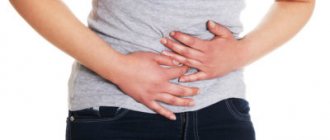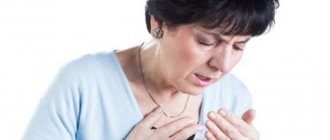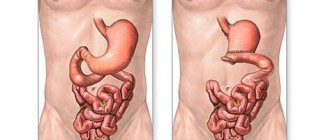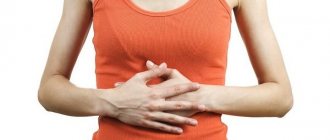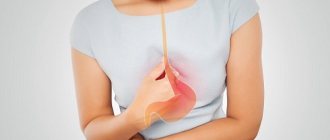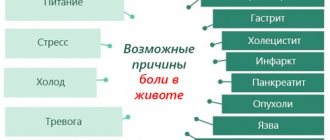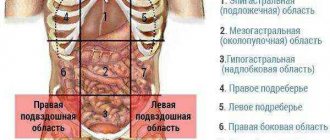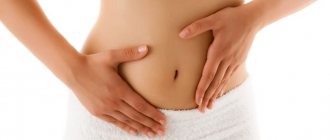Pain in the hypochondrium is a common symptom found in various diseases. As a diagnostic measure that facilitates the choice of treatment method, it is to determine the exact strength, nature and location of pain (right or left, front or back). More often, pain occurs due to a certain disease affecting the stomach, which is located in the upper left part of the abdomen.
Causes
Depending on the location of the pain syndrome, there are:
- Pain in the middle of the abdomen on the left under the ribs. The symptom indicates the development of gastritis, accompanied by severe inflammation in the stomach. Intense pain indicates the rapid development of pathology, which can be caused by many reasons. It hurts in this place due to dysbacteriosis that arose while taking strong antibiotics.
- With a sudden onset of pain and periodic repetition of colic on the right hypochondrium, changes in the liver are suspected, accompanied by inflammation of the bile ducts.
- Chronic pathologies cause dull, aching pain on the left side that does not go away for a long time. In the right hypochondrium, such pain symptoms are characteristic of inflammation of the intestinal mucosa and prolonged cholecystitis.
- Cramping colic indicates muscle spasms in the gastrointestinal tract due to pathological changes.
Soreness may be felt in different places on the right side. Each location indicates the development of pathology of a specific organ:
- Pain in the middle upper abdomen indicates dysfunction and inflammation in the large intestine.
- Pain closer to the navel indicates inflammation of the small intestine - enteritis.
- Colic between the ribs on the back indicates inflammation of the pleura of the chest, the development of a purulent abscess in the liver.
- Rare, short-lived colic in the right hypochondrium may indicate not pathologies, but various disorders:
- poor nutrition;
- long-term physical activity;
- fixed position, leaning forward;
- injuries;
- postoperative complications.
Possible diagnoses of the causes of pain in the upper abdomen
Typically, pain in the upper abdomen, as well as under the ribs or spoon, has characteristic symptoms, namely, they can be sharp, dull, aching or bursting. At the same time, the presented condition is traditionally accompanied by certain symptoms, namely vomiting. Patients indicate that, as a rule, painful sensations become even more intense as vomiting intensifies, and after it stops they weaken.
Experts associate pain in the upper abdomen, pit of the stomach or ribs with such serious diseases as gastritis and stomach ulcers. In this case, the most characteristic symptoms will help determine a specific ailment, namely pain that manifests itself exclusively as a result of consuming sour or spicy foods or drinks like coffee. It should be noted that even previously experienced stress can be a catalyst for the development of sensations.
Among other things, painful sensations can occur in the sternum along the esophagus or in the middle. In this regard, experts pay attention to certain characteristics of the condition:
- gastritis is a chronic form of disease of the gastrointestinal tract, the symptoms of which develop gradually, and therefore, when the very first problems with stool or bowel function appear, it is recommended to consult a doctor;
- A gastric ulcer is a much more acute condition that should be treated as quickly as possible to avoid the development of complications and critical consequences. This is very important for frequently recurring pain in the pit of the stomach, ribs or above;
- It is strongly recommended to undergo repeated diagnostics in order to accurately determine the diagnosis and differentiate gastritis or gastric ulcer from cancer, which can also be characterized by similar symptoms.
In general, no matter what part of the abdomen or peritoneum is associated with painful sensations and, especially, other symptoms, it is recommended not to engage in self-treatment or use of traditional methods of influence.
This is explained by the fact that if there is pain in the upper abdomen, under the ribs or in the pit of the stomach, there is a high probability of developing complications, which can only be avoided by starting a recovery course in time.
Acute pain in the stomach under the ribs
If the rib on the left and right hurts with characteristic dagger-like, sharp manifestations, this indicates the presence of a serious pathology that requires immediate qualified help and immediate treatment:
- Myocardial infarction. Additionally, it is manifested by cold, sticky sweat, nausea, shortness of breath, dizziness up to loss of consciousness. Body movements increase pain.
- Perforation of a gastric ulcer. Accompanied by pale skin, dizziness and even loss of consciousness. The sensations are aggravated by any movement.
- Splenic rupture. The pathology provokes blueness of the umbilical zone, swelling of the eyelids, a sharp drop in pressure, and fever.
- Strangulation of the stomach by a hernia located in the esophageal diaphragm. The pathology is accompanied by nausea with vomiting, shortness of breath, cyanosis of the skin, tachycardia, and a sharp drop in pressure. The vomit contains blood impurities. The condition is aggravated by turning, coughing and breathing.
- Exacerbations of urolithiasis. They cause nausea with vomiting, and blood appears in the urine.
Acute stabbing pain in the right or left hypochondrium occurs with the following diseases:
- An enlarged spleen, which puts pressure on the organs in acute viral mononucleosis. The navel area hurts, there is fever, thirst, weakness, dizziness. Lymph nodes become inflamed. Symptoms worsen with coughing and physical activity.
- Dry pleurisy on the left. Accompanied by an obsessive cough, heaviness and pressure in the chest, cyanosis of the face and fingers. The pain intensifies when coughing, exhaling, turning and bending. Swelling causes the lungs to put pressure on the diaphragm, therefore affecting the stomach, which begins to hurt when filled with food.
Surrounding sharp pain is characteristic of another list of diseases:
- Intercostal neuralgia. Many painful places appear on the body, especially between the ribs, weakness, migraines. The sensation is aggravated by sudden movements, sneezing, coughing, or inhaling, when the lungs expand and put pressure on the nerves.
- Acute pancreatitis. The pathology is accompanied by a burning sensation in the upper left hypochondrium, vomiting with bile impurities, obstructive jaundice, and darkening of urine. When eating heavy and irritating foods, alcohol, symptoms intensify. The pain can also spread to the right side.
- Osteochondrosis, which is located in the thoracic vertebra. The pathology is characterized by widespread pain and numbness.
Examination for epigastric pain
Particular attention should be paid to diagnosis when there is pain in the upper abdomen, under the ribs, at the top or in the pit of the stomach. This is what will help make the most accurate diagnosis and prescribe subsequent treatment. In this case, experts pay attention to the following points: it is necessary to seek medical help as early as possible (this will make it possible to make an accurate diagnosis) and exclude the use of any medicinal components, because they can distort the data as a result of the examination.
So, if the patient has pain in the epigastric region, as well as under the ribs, at the top or in the pit of the stomach, precise localization of the pain will be required. This will allow you to much more accurately determine the most likely causes and prescribe the appropriate treatment. If there is pain in the epigastric region, under the ribs, at the top or in the pit of the stomach, in the middle, you will need to take a horizontal position for initial diagnosis. As part of the examination, they carefully palpate the abdomen and find exactly the place that provokes the most painful sensations.
In the vast majority of cases, in the absence of complications or critical consequences, the localization of sensations and the affected organ coincide. However, deviations are likely, so experts insist on additional measures to determine the causes of pain in the epigastric region, under the ribs, at the top or in the pit of the stomach. Speaking about this, doctors point to the need to conduct a general blood test, monitor the level of leukocytes and other vital signs. In addition, an extensive analysis of urine and stool may be necessary.
The next mandatory step for identifying the exact cause is instrumental examination techniques.
We are talking about ultrasound, MRI or CT, x-rays and other methods that will be recommended directly by a specialist. All of them will help determine why it hurts under the ribs, in the upper abdomen or in the pit of the stomach. In some cases, the specialist doubts the diagnosis, and therefore a repeat diagnostic session is required. Only after this will it be possible to talk about what kind of diagnosis is associated with the specific sensations presented and what the recovery course should be.
Chronic pain
Dull, aching colic in the right or left hypochondrium indicates an exacerbation of chronic pathologies:
- Gastritis, stomach ulcer. The disease is accompanied by vomiting, nausea, an uncharacteristic taste in the mouth, heartburn, weakness, and increased sweating. If the diet is not followed, the symptoms worsen.
- Colitis. The pathology is accompanied by nausea with vomiting, false urge to defecate, diarrhea, rumbling, bloating and flatulence, and diarrhea.
- Initial stages of inflammation of the spleen. The pain is accompanied by weakness, lethargy, fatigue, loss of appetite, taste disturbance, constipation/diarrhea, nausea after eating.
- Infectious and inflammatory pathology of the renal system - pyelonephritis. It manifests itself as severe intoxication with weakness, fever, chills, and painful urination. The pain is aggravated by poor nutrition, hypothermia in wet and cold weather.
- Ischemia, angina. The ailments are accompanied by instability of pulse and blood pressure. Manifested by heaviness and burning in the chest, severe shortness of breath. Symptoms are aggravated by physical activity and stress.
- Left-sided pneumonia. Accompanied by a dry cough, pain in the muscles and head, fever, and weakness. Attacks of severe coughing intensify the pain, which becomes cutting.
Causes of pain under the ribs depending on location
The main factor provoking the occurrence of pain and discomfort in the subcostal area is the development of inflammatory processes. There may be other reasons for the appearance, ranging from pregnancy to the fact that there are malignant bone tumors in the body. The nature and location of the pain syndrome helps to accurately determine the pathology.
On right
Pain under the lower right rib can be caused by the following diseases and pathological processes:
- Inflammation of the gallbladder and abnormalities in the functioning of the biliary system. Accompanied, in addition to pain symptoms, by nausea. Later (as it develops), frequent vomiting appears.
- Cholecystitis is inflammation of the mucous membrane of the gallbladder walls. The pain syndrome is aching in nature.
- Gallstones. Acute painful sensations occur, aggravated by inhalation and coughing, and digestive problems.
- Cholesterosis is the deposition of excess cholesterol in the gallbladder. The pain is aching, almost constant, with increasing intensity during active movements. As the disease progresses, eating food causes nausea and vomiting.
- Common bile duct is the development of an inflammatory process on the intestinal walls. The pain symptoms are intense, similar to colic, which often worsen, and during those periods when there is no colic, there is an aching sensation.
Discomfort on the right side of the ribs is almost always caused by diseases and pathologies of the gallbladder and bile ducts. If pain occurs from above, this may be a symptom of diseases of the respiratory system, for example, right-sided pneumonia.
Upper right pain may be a sign of a rare disease called Tietze syndrome. With this pathology, the unpleasant sensations are dull, aching in nature, of moderate strength with rare and short-term intensification, and can radiate to the shoulder blade and upper limb.
Left
Discomfort under the lower left rib can be caused by injuries to the liver and spleen, and inflammatory processes in these organs. Often the unpleasant sensations below the left ribs are radiating. This means that the epicenter is located in the heart muscle, stomach, spinal column, and unpleasant symptoms radiate to the left hypochondrium. The most common causes of pain:
- pancreatitis, inflammation of the pancreas in acute or chronic course;
- spleen injuries, organ rupture;
- gastritis, inflammatory processes in the walls of the stomach;
- peptic ulcer;
- left-sided pleurisy;
- diaphragmatic hernia;
- chronic myeloid leukemia;
- diverticulitis;
- fibromyalgia;
- osteosarcoma of the ribs;
- colitis of the large intestine of ischemic type;
- vegetative-vascular dystonia;
- appendicitis – rare;
- perforated ulcer with perforation.
Sharp and severe pain in the upper left may indicate diseases such as angina pectoris, subdiaphragmatic abscess. Unpleasant sensations can be associated with pregnancy, when a woman's lung capacity increases. In this case, such sensations arise when you sigh. Pain in the upper part of the left hypochondrium can be provoked by an ischemic or gastralgic form of myocardial infarction, hypertonicity of the pectoral muscles.
At both sides
The causes of dorsalgia, which is localized in the back, covering the costal space on both sides, are diseases of the spinal column, hernia or spinal injury. Other reasons:
- osteochondrosis;
- neuralgia;
- retroperitoneal hematoma;
- diseases of the gastrointestinal tract, most often ulcers and gastritis;
- development of pancreatitis;
- mononucleosis;
- chronic liver diseases - cirrhosis or all types of hepatitis (in addition to pain, renal colic occurs, which is accompanied by jaundice);
- sepsis.
The causes of dorsalgia, which is localized in the back, covering the costal space on both sides, are spinal injuries.
Often pain (sharp, dull or aching) occurs as a result of various immune pathological processes.
In the middle
Pain in the middle rib space in most cases indicates a peptic ulcer. The painful sensations are so intense and acute that it is easier for the patient to endure them lying down, with his knees pulled up to his stomach. During an attack of an ulcer, unpleasant symptoms first appear in the epigastrium and gradually spread to the middle of the hypochondrium.
Shingles
This type of pain is characteristic of pancreatitis. In most cases it occurs suddenly and quickly increases in intensity. The symptom is called shingles because it covers the middle of the abdomen under the ribs, shoulder blades and the entire surface of the back. Symptoms worsen when moving, taking a deep breath, or coughing.
Exacerbation of pancreatitis (the main cause of girdle pain) is accompanied by nausea and vomiting, and blue discoloration of the skin. If help is not provided in a timely manner, a person’s blood pressure will begin to rapidly decrease, diarrhea will appear, and fat will be found in the stool. These signs may indicate the development of an oncological tumor in the pancreas.
Shingles can also be accompanied by shingles pain. A distinctive feature of the disease is that pain intensifies mainly at night and upon contact with the affected area of the skin.
Gastritis
The pain is dull or sharp. There is pain in the front of the ribs. With gastritis, the stomach becomes inflamed with an increase or normal level of acidity of the digestive juice. The pain syndrome intensifies on an empty stomach, as acidic digestive juice corrodes the walls of the organ. Eating does not relieve the pain, but can make it worse if the food is too hard or sour. Starch soups and jelly, which have an enveloping effect on the walls of the stomach, will help relieve food pain in the side. Signs of gastritis with high acidity:
- heartburn;
- unstable stool;
- tendency to constipation.
When aching colic occurs, accompanied by heaviness under the solar plexus, gastritis with low acidity develops. The condition worsens after eating. Characteristic signs of pathology:
- bitter, sour belching with pieces of food;
- vomiting, which brings relief.
Due to impaired absorption, weight quickly decreases, sweating increases, chronic anemia and vitamin B12 deficiency develop.
First aid for abdominal pain
If you experience sudden severe pain in the abdomen under the ribs (left, middle or right), the first thing to do is call an ambulance. Many diseases that cause similar symptoms require immediate medical attention. Otherwise, everything can end in emergency surgery, complications and even death.
To alleviate the condition before the ambulance arrives, you will need:
- ensure complete rest and, if possible, place the patient in a supine position;
- apply a cold compress to the place where severe pain is localized;
- if possible, administer an isotonic solution to the victim through a dropper (this measure is recommended if there is a suspicion of internal bleeding in the digestive system).
Do not apply warm compresses or heating pads to the area where the pain is located, because they accelerate blood circulation, enhance the development of the inflammatory process and can lead to serious, often irreversible consequences. It is not recommended to give painkillers, because they will “blur” the symptomatic picture, which will interfere with making a correct preliminary diagnosis.
Stomach and duodenal ulcers
These pathologies are characterized by sharp pain in the left hypochondrium and side, which occurs in the middle of the abdomen and radiates to the back or lower back. Attacks often appear at night, in the off-season (spring, autumn). To relieve pain, patients press the part of their abdomen that hurts. Peptic ulcers provoke pain on an empty stomach or 2-3 hours after eating. Colic can be caused by physical overexertion or stress.
Antacids can help your stomach. Patients improve their condition by applying a heating pad and washing with soda solutions. Additional signs of a duodenal ulcer with the stomach:
- heartburn;
- flatulence;
- constipation;
- migraine;
- weakness;
- irritability;
- weight loss
When to see a doctor
Many people sometimes have stomach pain. As a rule, after some time the symptoms go away. However, there are a number of situations that require immediate diagnosis and, in some cases, hospitalization.
You should urgently contact a gastroenterologist if:
- constantly increasing pain in the abdominal area;
- in the absence of any positive effect from taking medications (for example, if a person has bloating and the medications do not have any effect);
- obvious signs of intoxication (the appearance of severe vomiting or diarrhea);
- severe and even cutting pain with every urination;
- the appearance of bloody inclusions in urine or feces;
- the appearance of pain during a change in body position;
- receiving a severe abdominal injury, falling or being injured;
- acute pain at night;
- pain that is accompanied by a fever;
- the appearance of pain from touching the stomach.
Pain in the upper abdomen is a typical description of a symptom of many pathologies. Therefore, you should not treat yourself, as the situation can only get worse.
Stomach cancer
The first stages of cancer pathology are asymptomatic and without pain. The patient has:
- weight loss;
- eating habits change;
- there is an aversion to meat;
- the skin and sclera turn yellow;
- fatigue appears quickly.
In the final stages, it manifests itself as pain in the middle of the epigastrium, in the left or right side under the ribs. Gastritis with low acidity, polyps and ulcerative lesions of the gastric cardia degenerate into cancer.
Pancreatic diseases
Acute pancreatitis manifests itself as sudden, unbearable, shingles colic between the ribs. The pain syndrome is characterized by diffuseness, so the entire upper part of the abdominal cavity hurts down to the area between both shoulder blades. Such powerful discomfort provokes vomiting, which aggravates the malaise and pain. Nausea with vomiting is caused by the desire to eat and drink, so during an attack the patient must adhere to a strict fasting diet.
Inflammation of the pancreas is manifested by bluish skin, pinpoint hemorrhages at the navel, and a sharp drop in pressure. The symptoms are caused by poisoning of the bloodstream by glandular enzymes.
Nature of pain
To make a preliminary diagnosis, you need to understand the nature of the pain syndrome that occurs in the epigastric region:
- dull and nagging pain;
- colic;
- aching sensations;
- stabbing, mild or severe pain.
Variants of localization of painful sensations, the identification of which is important for diagnosis:
- at both sides;
- on the right side;
- on the left side (more details here);
- in the upper abdomen;
- in the lower part of the ribs, on the side;
- in the middle between the ribs, in the stomach;
- in front or behind the ribs, closer to the kidneys.
Unpleasant sensations in the abdomen, regardless of their location in relation to the ribs, are rarely the only symptom. This symptom is accompanied by a concomitant symptomatic picture, for example, elevated body temperature, nausea and vomiting, yellowing of the skin and mucous membranes.
Treatment and prevention
Abdominal pain radiating to the left or right to the side and under the ribs, of any intensity and nature, should alert a person, especially with existing chronic pathologies. In addition to the stomach, vital organs are located in the epigastric region. Only a specialist can diagnose the cause. If the left or right side under the ribs hurts, self-medication is strictly prohibited. This can aggravate the pathology and intensify symptoms. Before choosing a treatment regimen, the patient is sent for examination.
In case of a heart attack or rupture of the spleen, a perforated ulcer, or acute pancreatitis, medical examination is required. It is possible to use surgical and conservative treatment, which depends on the severity of the detected pathology. Preventive measures:
- avoiding excessive consumption of strong alcohol;
- reducing the amount of fatty and salty foods;
- annual medical examination;
- regular monitoring of chronic diseases through ultrasound to determine their degree of development;
- If you experience the first pain attacks under the left or right rib, consult a doctor.
Pain in the solar plexus as a cause of various diseases
The solar plexus is the center of our body. It is located under the diaphragm in the middle. Next to it are: respiratory organs, a small circle of blood circulation, digestive organs. Any acute disease of at least one of the systems will lead to damage to the solar plexus, including.
We recommend, first of all, to contact professional doctors. Because only they, with the help of medical equipment and special tests, can find out the cause and prescribe individual treatment.
We found out the TOP 5 most common diseases that can cause pain in the solar plexus.
- Neuritis is a direct disease of the solar plexus. With neuritis, the process of inflammation of the nerve endings occurs. The pain will appear regardless of the time of day.
Characteristics of pain: acute, sudden/sharp, intensifies when changing position. It is felt in the abdominal cavity, radiates to the stomach, lower back and sides.
Factors that influenced the occurrence: hard sports training, infections, injuries, stress, sedentary lifestyle.
What to do: the first thing you can do is take the fetal position. Next, you should consult a doctor who will prescribe medication after checking all organs.
- Solaritis is a lesion of the majority of nerve endings, nodes of the nervous system, which are located near the solar plexus. Pain will occur in the form of attacks and spasms.
Characteristics: dull, nagging pain in the abdominal area, between the ribs in the middle.
Symptoms appear and will persist for a long period if treatment is not started.
Factors: chronic diseases of the digestive system, ulcers.
What to do: Doctors prescribe treatment that will eliminate a previously known source of irritation using anti-inflammatory drugs.
- Pancreatitis is a disease of the pancreas. It is located next to the solar plexus, which causes spasmodic pain.
Characteristics of pain: pinpoint, cutting, nausea, vomiting, cramps, diarrhea.
Factors: poor diet, poor daily routine, frequent alcohol consumption.
What to do: Pancreatitis is one of the most dangerous diseases. Treatment should occur immediately. A diet and medications are prescribed.
- Gastritis is a chronic and acute disease of the stomach walls. Almost every third person on earth has it. It appears at an early age in children.
Characteristics of pain: burning, pain after eating, tingling.
Factors: poor diet, intake of fatty and spicy foods, bad habits, poor working conditions, long-term use of medications.
What to do: consult a doctor, go on a diet that includes light, bland food. Follow your doctor's recommendations and play sports.
- Duodenum is a disease of the duodenum. Manifests itself in the form of weakness, fatigue, and bouts of vomiting.
Characteristics of pain: nagging, aching pain in the stomach area. Occurs most often at night. Does not appear in a permanent form.
Factors: infection, hunger strike, strict diets.
What to do: doctors prescribe a general ultrasound, ultrasound of the solar plexus, anti-inflammatory drugs, and a balanced diet.
For pain in the solar plexus area, first of all, you need to find out the source. Of course, do this with the help of specialists. Knowing where the pain came from will help you solve this problem. The treatment of such diseases is carried out by: neurologists, gastroenterologists, and therapists.
There is no need to panic, but it is necessary to think and rethink your diet and add physical activity. After all, only the harmonious functioning of your organs will lead you to longevity and happiness.
- Why does my voice shrink? Hoarseness can be a sign of serious illness
- Biden failed to persuade the EU to a new “Munich agreement”
- Masks are off, Türkiye supported Pashinyan
- The West is still full of people who believe that Russia will fight them in a limited way
- Human rights activist Vakhapov told how Navalny was met in the colony
- China considers Siberia and the Far East its own. And waiting for the right moment?
Become a member of the CLAN and every Tuesday you will receive the latest issue of “Arguments of the Week” with a discount of more than 70%, along with exclusive materials not included in the newspaper. Get premium access to a library of the most interesting and popular books, as well as an archive of more than 700 published issues for FREE. In addition, you will have the opportunity to benefit from free legal advice from our experts for a whole year.
- Enter your email address, then select any convenient payment method for your annual subscription
- Scan the QR. In the Sberbank Online application that opens, enter the annual subscription cost (490 rubles). Then send the confirmation code by email
Or

